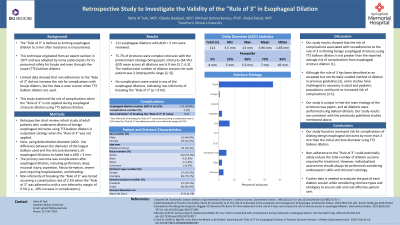Monday Poster Session
Category: Esophagus
P2191 - Retrospective Study to Investigate the Validity of the "Rule of 3" in Esophageal Dilation
Monday, October 28, 2024
10:30 AM - 4:00 PM ET
Location: Exhibit Hall E

Has Audio

Yahia Al Turk, MD
Southern Illinois University School of Medicine
Springfield, IL
Presenting Author(s)
Yahia Al Turk, MD, Obada Daaboul, MD, Michael Buhnerkempe, PhD, Abdul Swied, MD
Southern Illinois University School of Medicine, Springfield, IL
Introduction: The "Rule of 3" is defined as limiting esophageal dilation to 3 mm after resistance is encountered. This technique originated from an expert opinion in 1977 and was adopted by many endoscopists for its presumed safety for boujie and even through-the-scope (TTS) balloon dilators. Limited data showed that non-adherence to the "Rule of 3” did not increase the risk for complications with boujie dilators, but the data is even scarcer when TTS balloon dilators are used. This study examined the risk of complications when the "Rule of 3" is not applied during esophageal stricture dilation using TTS balloon dilators.
Methods: Retrospective chart review cohort study of all adult patients who underwent dilation of benign esophageal strictures using TTS balloon dilators in outpatient settings when the “Rule of 3” was not applied. Here, using delta dilation diameter (ΔDD - the difference between the diameter of the largest balloon used and the stricture diameter), all esophageal dilations included had a ΔDD > 3 mm. The primary outcome was complications after esophageal dilation, including perforation, deep mucosal injury, aspiration, fistula formation, severe pain requiring hospitalization, and bleeding. Non-inferiority of breaking the “Rule of 3” was tested assuming a complication rate of 2.5% when the “Rule of 3” was adhered to with a non-inferiority margin of 0.5% (i.e., 20% increase in complications).
Results: 111 esophageal dilations with ΔDD > 3 mm were reviewed. 75.7% of strictures were complex strictures with the predominant etiology being peptic strictures (64.5%). ΔDD mean across all dilations was 6.0 mm [5.7, 6.3]. The median total number of dilation sessions for each patient was 3 (Interquartile range [2, 5]). No complications were noted in any of the esophageal dilations, indicating non-inferiority of breaking the “Rule of 3” (p = 0.03).
Discussion: Our study found no increased complication risk associatiated with dilating benign esophageal strictures by more than 3 mm than the initial stricture diameter using TTS balloon dilators. Therefore, non-adherence to the "Rule of 3” could potentially safely reduce the total number of dilation sessions required for treatment. However, individualized assessment should always be performed considering the endoscopist’s skills and stricture’s etiology. Further data is needed to evaluate the goal of each dilation session while considering stricture types and etiologies to ensure safe and cost-effective patient care.
Disclosures:
Yahia Al Turk, MD, Obada Daaboul, MD, Michael Buhnerkempe, PhD, Abdul Swied, MD. P2191 - Retrospective Study to Investigate the Validity of the "Rule of 3" in Esophageal Dilation, ACG 2024 Annual Scientific Meeting Abstracts. Philadelphia, PA: American College of Gastroenterology.
Southern Illinois University School of Medicine, Springfield, IL
Introduction: The "Rule of 3" is defined as limiting esophageal dilation to 3 mm after resistance is encountered. This technique originated from an expert opinion in 1977 and was adopted by many endoscopists for its presumed safety for boujie and even through-the-scope (TTS) balloon dilators. Limited data showed that non-adherence to the "Rule of 3” did not increase the risk for complications with boujie dilators, but the data is even scarcer when TTS balloon dilators are used. This study examined the risk of complications when the "Rule of 3" is not applied during esophageal stricture dilation using TTS balloon dilators.
Methods: Retrospective chart review cohort study of all adult patients who underwent dilation of benign esophageal strictures using TTS balloon dilators in outpatient settings when the “Rule of 3” was not applied. Here, using delta dilation diameter (ΔDD - the difference between the diameter of the largest balloon used and the stricture diameter), all esophageal dilations included had a ΔDD > 3 mm. The primary outcome was complications after esophageal dilation, including perforation, deep mucosal injury, aspiration, fistula formation, severe pain requiring hospitalization, and bleeding. Non-inferiority of breaking the “Rule of 3” was tested assuming a complication rate of 2.5% when the “Rule of 3” was adhered to with a non-inferiority margin of 0.5% (i.e., 20% increase in complications).
Results: 111 esophageal dilations with ΔDD > 3 mm were reviewed. 75.7% of strictures were complex strictures with the predominant etiology being peptic strictures (64.5%). ΔDD mean across all dilations was 6.0 mm [5.7, 6.3]. The median total number of dilation sessions for each patient was 3 (Interquartile range [2, 5]). No complications were noted in any of the esophageal dilations, indicating non-inferiority of breaking the “Rule of 3” (p = 0.03).
Discussion: Our study found no increased complication risk associatiated with dilating benign esophageal strictures by more than 3 mm than the initial stricture diameter using TTS balloon dilators. Therefore, non-adherence to the "Rule of 3” could potentially safely reduce the total number of dilation sessions required for treatment. However, individualized assessment should always be performed considering the endoscopist’s skills and stricture’s etiology. Further data is needed to evaluate the goal of each dilation session while considering stricture types and etiologies to ensure safe and cost-effective patient care.
Disclosures:
Yahia Al Turk indicated no relevant financial relationships.
Obada Daaboul indicated no relevant financial relationships.
Michael Buhnerkempe indicated no relevant financial relationships.
Abdul Swied indicated no relevant financial relationships.
Yahia Al Turk, MD, Obada Daaboul, MD, Michael Buhnerkempe, PhD, Abdul Swied, MD. P2191 - Retrospective Study to Investigate the Validity of the "Rule of 3" in Esophageal Dilation, ACG 2024 Annual Scientific Meeting Abstracts. Philadelphia, PA: American College of Gastroenterology.
